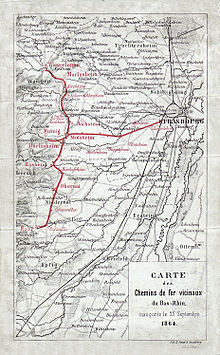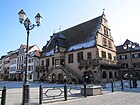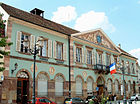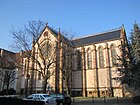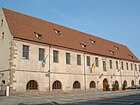Molsheim
| Molsheim | ||
|---|---|---|
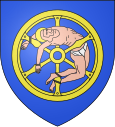
|
|
|
| region | Grand Est | |
| Department | Bas-Rhin | |
| Arrondissement | Molsheim | |
| Canton | Molsheim | |
| Community association | Region of Molsheim-Mutzig | |
| Coordinates | 48 ° 33 ' N , 7 ° 30' E | |
| height | 165-371 m | |
| surface | 10.85 km 2 | |
| Residents | 9,312 (January 1, 2017) | |
| Population density | 858 inhabitants / km 2 | |
| Post Code | 67120 | |
| INSEE code | 67300 | |
| Website | www.mairie-molsheim.fr | |
Molsheim (formerly also Mollesheim ; Alsatian : Molse ) is a French commune with 9,312 inhabitants (as of January 1, 2017) in the Bas-Rhin department in the Grand Est region (until 2015 Alsace ). It is the seat of the sub-prefecture (French: Sous-préfecture ) of the arrondissement of Molsheim and of the municipal association Région de Molsheim-Mutzig, founded in 1997 .
geography
The community on the river Bruche ( German Breusch ) is about 30 kilometers west of Strasbourg and ten kilometers north of Obernai at 180 m above sea level. NHN.
history
Molsheim was a center of the recatholicization of Alsace. A first wave came through the Jesuit settlements at the residence of the bishops of Strasbourg in Molsheim around 1580 and in Basel / Pruntrut in 1591. Father Jakob Ernfelder (1544–1601), later Provincial of the Rhenish Order Province, was the first rector of the Jesuit College from 1580 Molsheim. In June 1610, 1200 warriors of Archduke Leopold were besieged by Protestant allies in the fortress of Molsheim .
The second wave of recatholicization came through Jesuit settlements in the Habsburg area of influence, in Ensisheim in 1615 and Freiburg in 1620. While the first wave served to secure the rule of the bishops in their dioceses, the second, propaganda-oriented, aimed at an impact in the surrounding area. A special role had it played the establishment of Jesuit Colleges as a counterpoint to the Protestant universities in Strasbourg and Basel, particularly of Archduke Leopold V (Austria Tirol) , since 1602 bishop of Strasbourg , from 1619 also regent of Further Austria was promoted . In 1617 he set up a Jesuit academy in Molsheim with the right to award doctorates and in 1620 brought the Jesuits to the university in Freiburg . Leopold would have specifically expanded the Habsburg sphere of power on the Upper Rhine through the settlement of the Jesuits, but the turmoil of war that began in 1632 ended these efforts abruptly.
In 1846 Molsheim had 3531 inhabitants. In 1864, two railway lines were opened that crossed at Molsbach: an east-west line from Strasbourg to Mutzig (today Ligne de Strasbourg-Ville à Saint-Dié in French ) and a north-south line from Wasselonne to Barr (today Ligne in French de Sélestat à Saverne ). Around 1900 Molsheim had a Protestant and a Catholic church, an agricultural winter school, an electricity company and was the seat of a local court .
From 1871 to 1918 the city belonged to the Alsatian part of the realm of Alsace-Lorraine and thus to the German Empire ; it was the seat of the Molsheim district in the Lower Alsace district . The non-Catholic Reich leadership led u. a. to form the Alsace-Lorraine Center Party (ELZ).
coat of arms
The coat of arms of Molsheim shows the Roman officer Georg, because of his faith, tied on a wheel by Emperor Diocletian to break his bones. He is better known as a dragon slayer. It applies u. a. as patron of the Crusaders, England and Georgia. Georg is one of the 14 helpers in need and, according to his name, Georgios, which means "farmer", as a peasant patron.
The Saint George , broken on the wheel, the emblem of Molsheim
The coat of arms in a window of the Tübingen collegiate church
Demographics
| year | population | Remarks |
|---|---|---|
| 1872 | 3560 | |
| 1890 | 3103 | |
| 1905 | 3164 | with the garrison (a battalion of foot artillery No. 14), mostly Catholic residents, according to other information, 3162 residents |
| 1910 | 3163 |
| year | 1946 | 1954 | 1962 | 1968 | 1990 | 1999 | 2009 | 2017 |
| Residents | 4955 | 5739 | 6649 | 6928 | 7973 | 9335 | 9280 | 9312 |
Attractions
- The former church of the Jesuit College Sankt-Georg- und Dreifaltigkeitskirche is a baroque building in the post-Gothic style, built around 1615 to 1618 by Christoph Wamser with an organ by Johann Andreas Silbermann from 1781
- Metzig (Renaissance, 16th century), former house of the butcher's guild.
- Former city palace (Renaissance, 16th century), Château d'Oberkirch , including temporary residence of Jean-François-Thérèse Barbier (1754–1828), general during the French Revolutionary Wars and the Napoleonic Wars.
- Charterhouse (Baroque, 17th - 18th century), with almost three hectares one of the largest preserved Carthusian monasteries (Carthusian monasteries) in the Upper Rhine. Visible today is the front part of the Carthusian monastery with the prior's house, which today houses the city museum. The monastery church itself was destroyed.
- Chartreuse Garden , Cour des Chartreux, Rue de l'Hôpital, Molsheim.
- Poudriere , ruins of the powder tower at the end of the old city wall of Molsheim.
- Town hall (classicism, 18th century), Hôtel de ville.
- Forge tower (14th century), former city gate, porte des forgerons.
- Our Lady Chapel (neo-Gothic, 1860s), Chapelle “Notre Dame” , Chapelle des Chanoinesses (Canon). In 1836, the Augustinian Sisters from Dieuze (Mosel) founded the Couvent Notre-Dame school for girls . For over a century they devoted themselves to educating young girls from the area until the institute closed in 1954. The neo-Gothic chapel (1864–1867) planned by Lorraine architect Léon Vautrin has a cruciform floor plan and rose windows in the facade of the transept.
- Maison des Chanoines (19th century), canons' house .
- Hôtel de monnaie , formerly the location of the mint (1573–1722), then demolished, new building 56 m long, u. a. Factory and warehouse, today an event hall.
- Eglise Protestante (1900), Rue des Vosges, Molsheim.
- Ecole des Soeurs de Ribeauville in the Rue de l'Eglise, small school building of the Sisters of Divine Providence from Ribeauvillé on the Upper Rhine, Molsheim.
- Grenier des comtes , 1606, house of the tithe also called Grafenkast, tithe barn of the Bishop of Strasbourg.
- Moulin des Paysans of the toolmaker Jacques Coulaux in Molsheim.
- Old half-timbered houses and town houses (16th to 18th centuries).
Charterhouse - Chartreuse in Molsheim. The front part of the Carthusian monastery with the prior's house,
traffic
Cycle traffic: The Itinéraire cyclable européen (European cycle path) Molsheim – Strasbourg – Kehl– Offenburg begins in Molsheim .
economy
One of the first important entrepreneurs in Molsheim was Jacques Coulaux from Strasbourg, who had various types of steel items manufactured here in 1820, built factories and later built other plants in Alsace, in Gresswiller, Mutzig and Klingenthal. At times he also used the Hôtel de monnaie as a production site. He and his family were particularly well known and wealthy as an arms manufacturer. In Molsheim, the Canal Coulaux still reminds of him as the energy supplier at the time. The rue Jacques Coulaux in Molsheim was also named after him.
Automotive industry

Molsheim became known through the automobile manufacturer Ettore Bugatti (1881-1947), who had his vehicles manufactured in neighboring Dorlisheim from 1910 onwards . From 2005 to 2011, Bugatti Automobiles SAS, part of the Volkswagen group, produced exclusive sports cars ( Bugatti Veyron ) in small numbers there.
Another company in the automotive industry in Molsheim is the Mercedes-Benz plant for converting trucks into special -purpose vehicles, Mercedes-Benz Custom Tailored Trucks (CTT). These special utility vehicles include fire engines, garbage trucks, municipal vehicles (snow clearers, road sweepers, etc.), heavy-duty transporters such as the Actros SLT and more. In addition, the Unimog cabs are painted at the Mercedes-Benz plant in Molsheim and delivered "just-in-time" to the Wörth plant, as are various (laser) welded and bent parts for other Mercedes-Benz plants (Wörth, Gaggenau , Germersheim). Around 1500 tons of steel are processed every year. The four laser welding machines have outputs of 3 to 6 kW, and there are also six hydraulic bending presses and a mechanical bending machine available.
Other industrial companies
The lighting manufacturer Osram operates a plant in Molsheim.
Molsheim is also the headquarters of the Merck subsidiary Millipore SAS, which produces laboratory technology, among other things, and Messier-Bugatti, a subsidiary of Safran (aerospace technology).
Viticulture
Molsheim is on the Alsace Wine Route . Its location Bruderthal is one of the Alsace Grand Cru wines. The Cistercian monks who built it gave this location its name. It was mentioned for the first time in the history of Molsheim in 1316 when the Bishop of Strasbourg owned vineyards there.
From 1598 until they were expelled in 1792, the Carthusians of Molsheim had white wine produced on their monastery property, which as 'finch wine' became their main source of income. This wine, the grape variety is no longer known, was u. a. also delivered to the English royal family. The English are said to have sent a lord to the Charterhouse in Molsheim every year, who had to choose and order new supplies.
Town twinning
Molsheim has a partnership with the Lower Franconian municipality of Gerbrunn in the German state of Bavaria .
Personalities
sons and daughters of the town
- Anton von Klein (1746–1810), poet, linguist and publisher
- François-Joseph Westermann (1751–1794), general, the so-called butcher of the Vendée militaire , put down the Vendée uprising, guillotined in Paris under Robespierre .
- Joseph Armand von Nordmann (1759-1809), French Colonel and Austrian Lieutenant Field Marshal , born in Molsheim, died on July 6, 1809 in Wagram in the fight against Napoleon at the head of his troops. In his memory, the City of Vienna in the XXI. District a street called Nordmanngasse.
- Bruno Franz Leopold Liebermann (1759–1844), German Catholic theologian.
- Antoine-Henri de Latour-Foissac (1782–1855), general of the cavalry
- Camille Schneider (1900–1978), teacher and writer.
- Jean-Paul Bucher (1938–2011), trained chef and entrepreneur.
- Holzmanno Winterstein (* 1952), guitarist of gypsy jazz
Associated with Molsheim
- Berthold von Buchegg (before 1279–1353), Bishop of Speyer in 1328 and as Berthold II. Bishop of Strasbourg from 1328 to 1353, died in Molsheim.
- Gregor Rippel (1681–1729), theologian and clergyman, worked as a professor in Molsheim.
- Ettore Bugatti (1881–1947), Italian automobile manufacturer and designer.
- Ernest Friederich (1886–1954), racing driver and mechanic, cooperated with Jean Bugatti .
- Henri Meck (1897–1966), member of the Union populaire républicaine (UPR, German: Alsatian People's Party), Mayor of Molsheim.
- Jean Bugatti (1909–1939), French-Italian automobile designer, manufacturer and test driver.
literature
- Le Patrimoine des Communes du Bas-Rhin . Flohic Editions, Volume 1, Charenton-le-Pont 1999, ISBN 2-84234-055-8 , pp. 731-752.
Web links
- City's website
- St. George and Trinity Church. In: Structurae
- Illustration by Frans Hogenberg from 1610: After Dachstein was conquered, Lägert der Unierten haer, Fur Molsheim in the Strasburg monastery gutt, ... ( digitized version )
swell
- Monastery and town on the southern Upper Rhine in the late Middle Ages and in the early modern period Regional history department, historical seminar, University of Freiburg, 5. – 6. March 2010, Neuenburg am Rhein, contributor Waldschütz, Johannes
- The Chartreuse in Molsheim
- The toolmaker Coulaux in Molsheim
- The Moulin des Paysans of the toolmaker Coulaux in Molsheim
- 'Rue Jacques Coulaux' in Molsheim
- 2012 Cleaning of the Coulaux canal in Molsheim
- The Carthusian monastery in Molsheim
Individual evidence
- ^ Johann Friedrich Aufschlager: The Alsace: New historical-topographical description of the two Rhine departments, Volume 2 , JH Heitz, Strasbourg 1825, p. 356, full text in the Google book search
- ^ Timotheus Wilhelm Röhrich: History of the Reformation in Alsace and especially in Strasburg , Volume 3, p. 245, Strasbourg, 1832; (Digital scan)
- ^ Johann Daniel Wilhelm Richter : History of the Thirty Years' War, told from documents and other sources , Volume 2, Erfurt 1839, p. 141 ( online )
- ↑ a b c d M. Rademacher: German administrative history from the unification of the empire in 1871 to the reunification in 1990. (Online material for the dissertation, Osnabrück 2006)
- ↑ a b Meyer's Large Conversation Lexicon . 6th edition, Volume 14, Leipzig / Vienna 1908, p. 44 ( Zeno.org );
- ^ Complete geographic-topographical-statistical local lexicon of Alsace-Lorraine. Contains: the cities, towns, villages, castles, communities, hamlets, mines and steel works, farms, mills, ruins, mineral springs, etc. with details of the geographical location, factory, industrial and other commercial activity, the post, railway u. Telegraph stations and the like historical notes etc. Adapted from official sources by H. Rudolph. Louis Zander, Leipzig 1872, Sp. 40 ( online )


